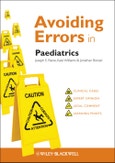Written for junior paediatric staff and consultants, and unlike any other paediatric clinical management title available, Avoiding Errors in Paediatrics identifies and explains the most common errors likely to occur in a paediatric setting - so that you won’t make them.
The first section in this brand new guide discusses the causes of errors in paediatrics. The second and largest section consists of case scenarios and includes expert and legal comment as well as clinical teaching points and strategies to help you engage in safer practice throughout your career. The final section discusses how to deal with complaints and the subsequent potential medico-legal consequences, helping to reduce your anxiety when dealing with the consequences of an error.
Invaluable during the Foundation Years, Specialty Training and for Consultants, Avoiding Errors in Paediatrics is the perfect guide to help tackle the professional and emotional challenges of life as a paediatrician.
Table of Contents
Contributors, viii
Foreword, ix
Abbreviations, xi
Introduction, xiii
Part 1
Section 1: Errors and their causes
A few words about error, 1
Learning from system failures – the vincristine case, 1
Person-centred paediatric errors and their causes, 8
The patient consultation, 10
Failure to identify a sick child, 12
Inability to perform practical procedures competently, 13
Failure to check test results or act on abnormal findings, 15
Prescribing errors, 16
Failures in resuscitation, 17
Sources of error in child protection cases, 19
References and further reading, 22
Section 2: Medico-legal aspects
Error in a legal context, 25
Negligence, 25
Medical negligence, 26
Issues around consent, 29
Confidentiality, 34
References and further reading, 37
Part 2 Clinical cases
Introduction, 39
Case 1 A boy with a limp, 40
Case 2 A fitting infant, 43
Case 3 A persistent fever, 45
Case 4 A biking injury, 48
Case 5 A teenager with abdominal pain, 51
Case 6 A young girl with a vaginal discharge, 54
Case 7 An iatrogenic problem, 57
Case 8 An infant with a large head, 59
Case 9 An infant with bloody diarrhoea, 62
Case 10 An infant with persistent jaundice, 64
Case 11 A child with leukaemia and tummy ache, 66
Case 12 A boy with fever and rigors, 68
Case 13 A stiff hand, 70
Case 14 A serious feeding problem, 72
Case 15 Fits, faints and funny turns, 74
Case 16 A hospital acquired infection, 76
Case 17 Recurrent wheeze, 79
Case 18 A jaundiced neonate, 82
Case 19 A febrile boy with a limp, 85
Case 20 A febrile neonate, 87
Case 21 A neonate with abnormal movements, 89
Case 22 A teenager with scrotal pain, 91
Case 23 A boy with nonspecific symptoms, 93
Case 24 A delayed walker, 96
Case 25 A diabetic girl with a headache, 98
Case 26 A boy with sickle cell disease and a fever, 101
Case 27 Negative test results, 104
Case 28 A bad case of ‘flu, 107
Case 29 A difficult transfer, 110
Case 30 Treatment for tonsillitis, 112
Case 31 Increasing respiratory distress, 114
Case 32 A feverish girl with poor feeding, 116
Case 33 An infant with a swollen face, 118
Case 34 Starting a new treatment, 121
Case 35 The importance of interpretation, 124
Case 36 A febrile boy with a scald, 126
Part 3 Investigating and dealing with errors
1 Introduction, 129
2 How hospitals try to prevent errors and their recurrence, 129
3 The role of hospital staff, 134
4 External investigators, 136
5 Hospital investigations, 138
6 Legal advice – where to get it and how to pay, 143
7 External inquiries, 146
8 The role of the doctor, 165
9 Emotional repercussions, 167
10 Conclusion, 169
References and further reading, 169
Index, 171








